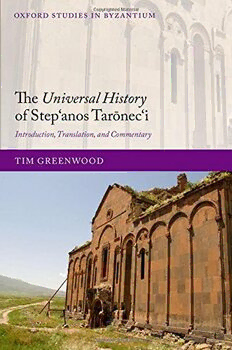
The Universal History of Stepʻanos Tarōnecʻi: Introduction, Translation, and Commentary PDF
Preview The Universal History of Stepʻanos Tarōnecʻi: Introduction, Translation, and Commentary
OXFORD STUDIES IN BYZANTIUM EditorialBoard JAMESHOWARD-JOHNSTON ELIZABETHJEFFREYS MARC LAUXTERMANN PAULMAGDALINO HENRYMAGUIRE CYRILMANGO MARLIAMANGO JEAN-PIERRESODINI JONATHANSHEPARD OXFORDSTUDIESINBYZANTIUM Oxford Studies in Byzantium consists of scholarly monographs and editions on the history,literature,thought,andmaterialcultureoftheByzantineworld. HolySitesEncircled TheEarlyByzantineConcentricChurchesofJerusalem VeredShalev-Hurvitz Law,Power,andImperialIdeologyintheIconoclastEra c.680–850 M.T.G.Humphreys ByzantiumandtheTurksintheThirteenthCentury DimitriKorobeinikov WritingandReadingByzantineSecularPoetry,1025–1081 FlorisBernard TheByzantine–IslamicTransitioninPalestine AnArchaeologicalApproach GideonAvni ShapingaMuslimState TheWorldofaMid-Eighth-CenturyEgyptianOfficial PetraM.Sijpesteijn NiketasChoniates AHistoriographicalStudy AliciaSimpson Byzantines,Latins,andTurksintheEasternMediterraneanWorldafter1150 EditedbyJonathanHarris,CatherineHolmes,andEugeniaRussell DebatingtheSaints’CultsintheAgeofGregorytheGreat MatthewDalSanto TheEmbodiedIcon LiturgicalVestmentsandSacramentalPowerinByzantium WarrenT.Woodfin ‘WehavenokingbutChrist’ ChristianPoliticalThoughtinGreaterSyriaontheEveoftheArabConquest (c.400–585) PhilipWood TillingtheHatefulEarth AgriculturalProductionandTradeintheLateAntiqueEast MichaelDecker The Universal History ‘ ō ‘ of Step anos Tar nec i Introduction, Translation, and Commentary TIM GREENWOOD 1 3 GreatClarendonStreet,Oxford,OX26DP, UnitedKingdom OxfordUniversityPressisadepartmentoftheUniversityofOxford. ItfurtherstheUniversity’sobjectiveofexcellenceinresearch,scholarship, andeducationbypublishingworldwide.Oxfordisaregisteredtrademarkof OxfordUniversityPressintheUKandincertainothercountries ©TimGreenwood2017 Themoralrightsoftheauthorhavebeenasserted FirstEditionpublishedin2017 Impression:1 Allrightsreserved.Nopartofthispublicationmaybereproduced,storedin aretrievalsystem,ortransmitted,inanyformorbyanymeans,withoutthe priorpermissioninwritingofOxfordUniversityPress,orasexpresslypermitted bylaw,bylicenceorundertermsagreedwiththeappropriatereprographics rightsorganization.Enquiriesconcerningreproductionoutsidethescopeofthe aboveshouldbesenttotheRightsDepartment,OxfordUniversityPress,atthe addressabove Youmustnotcirculatethisworkinanyotherform andyoumustimposethissameconditiononanyacquirer PublishedintheUnitedStatesofAmericabyOxfordUniversityPress 198MadisonAvenue,NewYork,NY10016,UnitedStatesofAmerica BritishLibraryCataloguinginPublicationData Dataavailable LibraryofCongressControlNumber:2016954558 ISBN 978–0–19–879251–2 Printedandboundby CPIGroup(UK)Ltd,Croydon,CR04YY LinkstothirdpartywebsitesareprovidedbyOxfordingoodfaithand forinformationonly.Oxforddisclaimsanyresponsibilityforthematerials containedinanythirdpartywebsitereferencedinthiswork. To Gilly Preface The Universal History of Step‘anos Tarōnec‘i (Stephen of Tarōn) offers an Armenian perspective on the history of the world, in three books, from the seventy-fifth year of Abraham to the turn of the first millennium. It was completed in the year 1004/5 CE, in an era when the Byzantine Empire was expanding eastwards and seizing control by various means of the districts of western and central Armenia. Eager to describe and analyse the processes of political, social, and cultural change which accompanied this expansion, historians haveturnedtobookIII—thelongestofthethree,focusedpredomin- antlyonthesecondhalfofthetenthcentury—andhavecomeawaydisappointed. Although it records the Byzantine expansion, it does so through a series of terseentrieswhichdonotofferfurthercommentorresponse.Noticesrecord- ingtheinteractionsoflocalArmenian,Georgian,Muslim,andKurdishelites are scarcely more forthcoming. Instead book III is dominated by a long theological letter addressed to the metropolitan of Sebasteia defending the Armenianconfessionoffaithandhighlightingfailingsinthecurrentpractices oftheImperialChurch.AlthoughscholarsofmedievalArmenia,Byzantium, and the Caucasus have exploited the Universal History as a contemporary composition,invariablytheyhaveturnedtoothersourcesinordertosupple- mentitsbriefnarrative. This study of the author and his work takes a very different approach. It treats the whole composition as a reflection of the historical context within which Step‘anos was working, arguing that his decision to compose a world history was not accidental. Step‘anos fused Armenian tradition with Roman, Persian, and Islamic history for a purpose, allowing him to demonstrate that Armeniahadanancientoriginandlong-standingtieswiththeseotherpowers, tieswhichwererootedinplace,time,andcircumstance.Thisrecoursetothe pastwasdesignedtoshapeandreinforcewhatitmeanttobeArmenianinthe present,atatimewhenitwascomingundersustainedpressure.Furthermore although the contents of books I and II are derivative, lifted from known works forthemost part, theextracts chosenby Step‘anos and, more particu- larly, the revisions made by him, reveal a clear antipathy to Byzantium. This permitsamorenuancedinterpretationofbookIII,withthetheologicalletter now central to the whole, operating as a defiant response to the Imperial Church as well as an assertion of Armenian parity with, and independence from,Byzantineintellectualandreligiousculture. YettheUniversalHistorycomprisesmuchmorethanacritiqueofByzantium. Although it might seem counter-intuitive, this study proposes that Step‘anos viii Preface turned to a Byzantine historical composition structured around the imperial sequence as the chronological spine for book III. Several details about the Byzantine past preserved by Step‘anos are unique. From an Armenian per- spective,alongsidethesequencesofkings,princes,andclericalleaders,books IIandIIIrecordprominentmonasticcommunitiesandscholars.Theirinclu- sionmaybeconnectedtoStep‘anos’ownresponsibilitieswithintheArmenian Church,buthisdecisiontoaffordthemsuchprominencemayalsoberelated to his conception of Armenian identity, constructing it in terms of cultural memory and tradition as well as historic political and territorial expression. Hisvisitstothesemonasticcommunitiesmayalsoaccountformuch,ifnotall, ofthelocalinformationwhichfindsitswayintobookIII,includingreflections on Buyid hegemony and the actions and interactions of local Sallārid, Raw- wādid, and Marwānid amirs. Intriguingly, his knowledge and experience of monastic communities did not extend south into the Arcruni kingdom of Vaspurakan, nor east and south-east into the districts of Siwnik‘, and it is striking that book III offers little on the affairs of these parts of historic Armenia. The Universal History of Step‘anos Tarōnec‘i emerges as a sophisticated composition, assembled at a time when traditional markers of Armenian identitywerebeingtransformedthroughsustainedengagementwitharesur- gent Byzantium. It represents one scholarly response to these changing circumstances, advancing a vision of world history which included, and thereby validated, Armenian tradition. As such, it reminds us that medieval historiesaremorethanmerelyrecordsofwhathappened.Everycomposition reflectsthecontextsinwhichitwascomposedandtheresponsesofitsauthor. The Universal History introduces us to the mind and the world of Step‘anos Tarōnec‘i. Acknowledgements Just as Step‘anos combined absolute and relative chronologies within his Universal History to measure the course of world history, so the duration of thisresearchprojectcanbereckonedindifferentways.Fromaninstitutional point of view, it was begun during the period of a postdoctoral research fellowship held in the Oriental Institute at the University of Oxford and completed in the tenth year after my appointment to a lectureship at the UniversityofStAndrews.Fromanannularperspective,someinitialthoughts on the text and its author were presented at the Ninth General Conference of the Association Internationale des Études Arméniennes in Würzburg on 10October2002;andthefull draftwas senttotheEditorialBoardof Oxford Studies in Byzantium on 7 September 2015. Or to reflect from a personal viewpoint, our daughter Eleanor was a 1-year old toddler when I began this studyandembarkingonherpreparationforpublicGSCEexaminationswhen Ifinished.Whichevercalibrationoneprefers,thereisnoavoidingthefactthat thisprojecthastakenaverylongtimeindeed. I should like to extend my sincere thanks to the Faculty of the Oriental Institute in Oxford for the award of a postdoctoral fellowship, during which the initial research was conducted, and to my colleagues in the School of History at the University of St Andrews, for the award of a semester of research leave in 2014/15, during which the study was completed. I am indebtedtoalargenumberofcolleaguesandfriendsfortheirencouragement, wise counsel, and assistance, including Ali Ansari, Juan Signes Codoñer, CatherineHolmes,JamesHoward-Johnston,HughKennedy,DimitriKastritsis, Simon MacLean, Ruth Macrides, Paul Magdalino, Andrew Marsham, Karen Mat‘evosyan, Paruyr Muradyan, Andrew Peacock, Ioanna Rapti, Chase Robinson, Angus Stewart, Luke Treadwell, Robert Thomson, Theo van Lint, EddaVardanyan,MaryWhitby,andMarkWhittow.Ishouldliketoacknow- ledge the contributions of James Mercer and Charlie Fidler in supplying the imageforthefrontcover,andEmmaDove,whopreparedthemaps.Ishould alsoliketoexpressparticularthankstoasuccessionoffinal-yearundergradu- ateclassesattheUniversityofStAndrewswhoencounteredandrespondedto extractsfrombookIIIintheirstudyoftenth-centuryByzantium.Totheearly cohorts who were presented with substantial unannotated blocks of text for analysis,Icanonlyapologize. Between 2003 and 2007, a series of different papers on aspects of the structure and contents of the Universal History were presented at research seminarsinOxford,Birmingham,Queen’sBelfast,andColumbia,NewYork, and I am grateful for the thoughtful questions and comments on these
